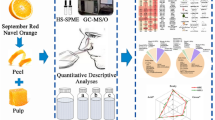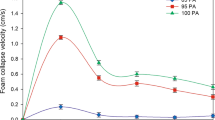Abstract
Pyment is a type of mead that is produced from the alcoholic fermentation of a honey solution with the addition of grape juice. Due to the demand for new beverages, pyment can be a profitable alternative for both grape and honey producers. Therefore, this work aimed to characterize the aromatic and physicochemical composition of pyments. The pyments were prepared with addition of 10, 20 and 30% of Moscato juice, and compared with Moscato wine and traditional mead. The results showed an increase in the fermentation rates of Moscato-pyments, indicating that the addition of Moscato juice reverses the low fermentative vigor often reported in mead fermentations. Physicochemical parameters showed an increase in total acidity and a decrease in residual sugar and alcohol, depending on Moscato juice concentration. Moscato-pyments showed an intermediate concentration of volatile compounds between the traditional mead and Moscato wine, with a better balance between fruity, floral and buttery, manifesting characteristic aromas of wines made with Moscato grapes and simultaneously, exposing characteristic aromas of honey. The sensory analysis reveals a significant difference between mead, pyments and Moscato wine. In general, pyments were considered, by the panelists, as the most equilibrated with intermediary aroma intensity, floral, fruity and honey aromas, and good persistence in the mouth.



Similar content being viewed by others
Availability of data and material
The data that support the findings of this study are available from the corresponding author, Luisa Vivian Schwarz, upon request.
References
Barbosa FS, Scavarda AJ, Sellitto MA, Marques DIL (2018) Sustainability in the winemaking industry: An analysis of Southern Brazilian companies based on a literature review. J Clean Prod 192:80–87. https://doi.org/10.1016/j.jclepro.2018.04.253
Catania CD, e Avagnina S (2010) La interpretación sensorial del vino. INTA
Diaz-Maroto MC, Schneider R, Baumes R (2005) Formation pathways of ethyl esters of branched short-chain fatty acids during wine aging. J Agric Food Chem 53:3503–3509. https://doi.org/10.1021/jf048157o
Duan LL, Shi Y, Jiang R, Yang Q, Wang TQ, Liu PT, Duan CQ, Yan GL (2015) Effects of adding unsaturated fatty acids on fatty acid composition of Saccharomyces cerevisiae and major volatile compounds in wine. S Afr J Enol Vitic 36:285–295
Ebeler SE, Thorngate JH (2009) Wine chemistry and flavor: looking into the crystal glass. J Agric Food Chem 57:8098–8108. https://doi.org/10.1021/jf9000555
Garde-Cerdán T, Ancín-Azpilicueta C (2008) Effect of the addition of different quantities of amino acids to nitrogen-deficient must on the formation of esters, alcohols, and acids during wine alcoholic fermentation. LWT Food Sci Technol 41:501–510. https://doi.org/10.1016/j.lwt.2007.03.018
Gomes T, Dias T, Cadavez V, Verdial J, Morais JS, Ramalhosa E, Estevinho LM (2015) Influence of sweetness and ethanol content on mead acceptability. Pol J Food Nutr Sci 65:137–142. https://doi.org/10.1515/pjfns-2015-0006
Gupta JK, Sharma R (2009) Production technology and quality characteristics of mead and fruit-honey wines: a review. NOPR 8:345–355
Guth H (1997) Identification of character impact odorants of different white varieties. J Agric Food Chem 45:3022–3026. https://doi.org/10.1021/jf9608433
Herbert J (2015) American Mead Maker’s 2nd annual mead industry report. American mead maker. http://issuu.com/americanmead/docs/amma_15.1. Accessed 08 Jul 2021
Hermośin I, Chicon RM, Cabezudo MD (2003) Free amino acid composition and botanical origin of honey. Food Chem 83:263–268. https://doi.org/10.1016/s0308-8146(03)00089-x
IBGE. Sistema IBGE de Recuperação Automática - SIDRA. Censo agropecuário 2017: Tabela 50.6622 - Número de estabelecimentos agropecuários com apicultura, quantidade de mel e cera de abelha vendidos e total de caixas de abelha - resultados preliminares. https://sidra.ibge.gov.br/pesquisa/censo-agropecuario/censo-agropecuario-2017. Accessed 08 Jul 2021
Iglesias A, Pascoal A, Choupina AB, Carvalho CA, Fea´s X, Estevinho LM, (2014) Developments in the fermentation process and quality improvement strategies for mead production. Molecules 19:12577–12590. https://doi.org/10.3390/molecules190812577
Jerković I, Kuś PM (2014) Terpenes in honey: occurrence, origin and their role as chemical biomarkers. RSC Adv 4:31710–31728. https://doi.org/10.1039/C4RA04791E
Lawless HT, Heymann H (2010) Sensory evaluation of food: principles and practices, 2nd edn. Springer Science & Business, New York NY. https://doi.org/10.1007/978-1-4419-6488-5
Marcon AR, Schwarz LV, Dutra SV, Delamare APL, Gottardi F, Parpinello GP, Echeverrigaray S (2019) Chemical composition and sensory evaluation of wines produced with different Moscato varieties. BIO Web Conf 12:02033. https://doi.org/10.1051/bioconf/20191202033
Marquele-Oliveira F, Carrão DB, De Souza RO, Baptista NU, Nascimento AP, Torres EC, Moreno GP, Buszinski AFM, Miguel FG, Cuba GL, dos Reis F, Lambertucci J, Redher C, Berretta AA (2017) Fundamentals of Brazilian honey analysis: an overview. In: de Toledo VAA (ed) Honey analysis, Chapter 7. Intershoper, pp 139–170. https://doi.org/10.5772/67279
Mendes-Ferreira A, Cosme F, Barbosa C, Falco V, Inês A, Mendes-Faia A (2010) Optimization of honey-must preparation and alcoholic fermentation by Saccharomyces cerevisiae for mead production. Int J Food Microbiol 144:193–198. https://doi.org/10.1016/j.ijfoodmicro.2010.09.016
Noordeloos S, Nagel CW (1972) Effect of sugar on acid perception in wine. Am J Enol Vitic 23:139–143
Pereira AP, Mendes-Ferreira A, Oliveira JM, Estevinho LM, Mendes-Faia A (2014) Effect of Saccharomyces cerevisiae cells immobilisation on mead production. LWT-Food Sci Technol 56:21–30. https://doi.org/10.1016/j.lwt.2013.11.005
Pires EA, Ferreira MA, da Silva SMPC, Santos FL (2013) Estudo prospectivo do hidromel sob o enfoque de documento de patentes. Geintec 3:033–041. https://doi.org/10.47059/geintecmagazine.v3i5.286
Pires EJ, Teixeira JA, Brányik T, Vicente AA (2014) Yeast: the soul of beer’s aroma—a review of flavour-active esters and higher alcohols produced by the brewing yeast. Appl Microbiol Biotechnol 98:1937–1949. https://doi.org/10.1007/s00253-013-5470-0
Ribéreau-Gayon P, Dubourdieu D, Done`che B, Lonvaud A (2006) Handbook of enology, vol 1: the microbiology of wine and vinifications. Wiley, Hoboken
Rizzon LA, Salvado MBA, Miele A (2008) Teores de cátions dos vinhos da Serra Gaúcha. Ciênc Tecnol Alimen 28:635–641. https://doi.org/10.1590/S0101-20612008000300020
Saénz-Navajas MP, Ballester J, Pêcher C, Peyron D, Valentin D (2013) Sensory drivers of intrinsic quality of red wines: Effect of culture and level of expertise. Food Res Int 54:1506–1518. https://doi.org/10.1016/j.foodres.2013.09.048
Schwarz LV, Marcon AR, Delamare APL, Agostini F, Moura S, Echeverrigaray S (2020) Selection of low nitrogen demand yeast strains and their impact on the physicochemical and volatile composition of mead. J Food Sci Technol 57:2840–2851. https://doi.org/10.1007/s13197-020-04316-6
Schwarz LV, Marcon AR, Delamare APL, Echeverrigaray S (2021) Influence of nitrogen, minerals and vitamins supplementation on honey wine production using response surface methodology. J Apic Res 60(1):57–66. https://doi.org/10.1080/00218839.2020.1793277
Sroka P, Tuszynski T (2007) Changes in organic acid contents during mead wort fermentation. Food Chem 104:1250–1257. https://doi.org/10.1016/j.foodchem.2007.01.046
Teramoto Y, Sato R, Ueda S (2005) Characteristics of fermentation yeast isolated from traditional Ethiopian honey wine, ogol. Afr J Biotechnol 4:160–163. https://doi.org/10.5897/AJB2005.000-3032
Vidrih R, Hribar J (2016) Mead: the oldest alcoholic beverage. In: Kristbergsson K, Oliveira J (eds) Traditional foods. Integrating Food science and engineering knowledge into the food chain, vol 10. Springer, Boston, pp 325–338. doi: https://doi.org/10.1007/978-1-4899-7648-2_26
Welke JE, Manfroi V, Zanus M, Lazzarotto M, Zini CA (2013) Differentiation of wines according to grape variety using multivariate analysis of comprehensive two-dimensional gas chromatography with time-of-flight mass spectrometric detection data. Food Chem 141:3897–3905. https://doi.org/10.1016/j.foodchem.2013.06.100
Welke JE, Zanus M, Lazzarotto M, Zini CA (2014) Quantitative analysis of headspace volatile compounds using comprehensive two-dimensional gas chromatography and their contribution to the aroma of Chardonnay wine. Food Res Int 59:85–99. https://doi.org/10.1016/j.foodres.2014.02.002
Zanus MC (2014) Espumante Moscatel – o sabor certo para sua sobremesa. http://www.cnpuv.embrapa.br/publica/artigos/moscatel.html. Accessed 08 Jul 2021
Acknowledgements
This work was financially supported by the The National Council for Scientific and Technological Development-CNPq (Universal- 431538/2016-6), the Coordenação de Aperfeiçoamento de Pessoal de Nivel Superior (CAPES, finance code 001), and the University of Caxias do Sul, Brazil. Moreover, we thank the Cooperativa Vinícola Garibaldi for kindly provided Moscato juice, and the enologists that participated in the sensory panel.
Funding
This work was financially supported by the The National Council for Scientific and Technological Development-CNPq (Universal- 431538/2016–6), the Coordenação de Aperfeiçoamento de Pessoal de Nivel Superior (CAPES, finance code 001), and the University of Caxias do Sul, Brazil.
Author information
Authors and Affiliations
Contributions
LVS, ARM, APLD and SE conceived and planned the experiments, and carried out the experiments. FA and SMS performed the Analysis of volatile compounds. All authors contributed to the final version of the manuscript and provided critical feedback and helped shape the research, analysis and manuscript.
Corresponding author
Ethics declarations
Conflict of interest
The authors declare that the research was conducted in the absence of any commercial or financial relationships that could cause conflict of interest.
Additional information
Publisher's Note
Springer Nature remains neutral with regard to jurisdictional claims in published maps and institutional affiliations.
Rights and permissions
About this article
Cite this article
Schwarz, L.V., Marcon, A.R., Delamare, A.P.L. et al. Aromatic and sensorial characterization of “Moscato pyments”: an innovative beverage. J Food Sci Technol 59, 3530–3539 (2022). https://doi.org/10.1007/s13197-021-05347-3
Revised:
Accepted:
Published:
Issue Date:
DOI: https://doi.org/10.1007/s13197-021-05347-3




